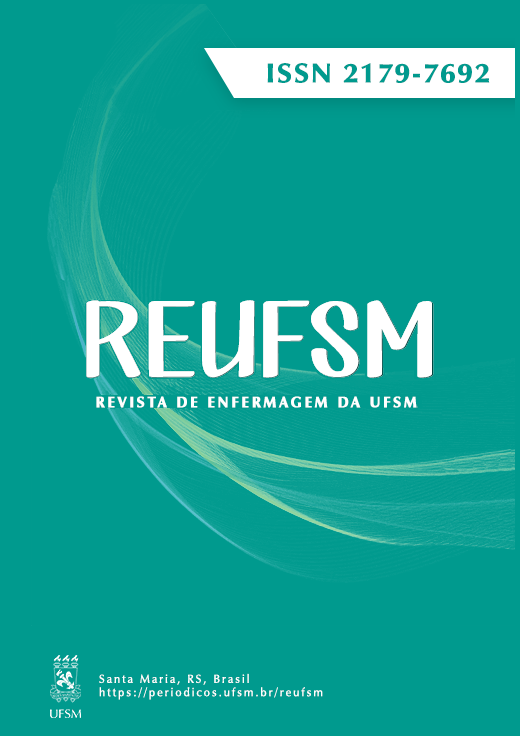“ROBOVID” mobile application about COVID-19 and target population: semantic validation study
DOI:
https://doi.org/10.5902/2179769273460Keywords:
Validation study, Covid-19, Nursing, Mobile applications, Health educationAbstract
Objective: to semantically validate the “ROBOVID” mobile application with the target population. Method: methodological study, presenting the seventh stage of the matrix project, developed between October 2021 and January 2022, with 21 adults residing in the state of Rio de Janeiro, using a semi-structured electronic form. The Concordance Index was used in the data analysis, being considered a validated item that presented a value equal to or greater than 80%. Results: the ROBOVID mobile application was validated, reaching satisfactory individual agreement rates ranging from 95% to 100% and global 98.8%. Conclusion: the mobile application “ROBOVID” was semantically validated in terms of content and appearance by the target population, indicating that this educational technology is understandable, relevant and pertinent, and can be used by the population as a tool for the prevention and control of serious sequelae resulting from covid-19.
Downloads
References
Abd EW, Eassa SM, Metwally M, Al-Hraishawi H, Omar SR. SARS-CoV-2 transmission channels: a review of the literature. MEDICC Rev. 2020 Oct;22(4):51-69. doi: 10.37757/MR2020.V22.N4.3
Gates B. Responding to covid-19: a once-in-a-century pandemic? N Engl J Med. 2020 Apr 30;382(18):1677-9. doi: 10.1056/NEJMp2003762
Grisotti M. Pandemia de covid-19: agenda de pesquisas em contextos de incertezas e contribuições das ciências sociais. Physis. 2020;30(2):e300202. doi: 10.1590/S0103-73312020300202
Patel KP, Vunnam SR, Patel PA, Krill KL, Korbitz PM, Parker M, et al. Transmission of SARS-CoV-2: an update of current literature. Eur J Clin Microbiol Infect Dis. 2020 Nov;39(11):2005-11. doi: 10.1007/s10096-020-03961-1
Henriques CMP, Vasconcelos W. Crises dentro da crise: respostas, incertezas e desencontros no combate à pandemia da covid-19 no Brasil. Estud Av. 2020;34(99). doi: 10.1590/s0103-4014.2020.3499.003
Leite SS, Áfio ACE, Carvalho LV, Silva JM, Almeida PC, Pagliuca LMF. Construction and validation of an Educational Content Validation Instrument in Health. Rev Bras Enferm. 2018;71(Suppl 4):1635-41. doi: 10.1590/0034-7167-2017-0648
Silva ACSS, Góes FGB, Ávila FMVP, Goulart MCL, Pinto LF, Stipp MAC. Construction and validation of a mobile application for health education about COVID-19. Rev Gaúcha Enferm. 2022;43:e20210289. doi: 10.1590/1983-1447.2022.20210289.en
Polit DF, Beck CT. Fundamentos de pesquisa em enfermagem: avaliação de evidências para a prática da enfermagem. 9ª ed. Porto Alegre: Artmed; 2019. 670 p.
Decker MJ, Harrison S, Price M, Gutmann-Gonzalez A, Yarger J, Tenney R. Educators' perspectives on integrating technology into sexual health education: implementation study. JMIR Hum Factors. 2022;9(1):e31381 doi: 10.2196/31381
Naderifar M, Ghaljaei F, Goli H. Snowball sampling: snowball sampling: a purposeful method of sampling in qualitative research. 2017;14(3): e67670. doi: 10.5812/sdme.67670
Figueiredo SV, Moreira TMM, Mota CS, Oliveira RS, Gomes ILV. Creation and validation of a health guidance booklet for family members of children with sickle cell disease. Esc Anna Nery Rev Enferm. 2019;23(1):1-10. doi: 10.1590/2177-9465-ean-2018-0231
Cruz FOAM, Faria ET, Reis PED. Validation of an educational manual for breast cancer patients undergoing radiotherapy. Rev Latinoam Enferm. 2020;28:e3384. doi: 10.1590/1518-8345.3197.3384
Shen J, Ghatti S, Levkov NR, Shen H, Sen T, Rheuban K, et al. A survey of covid-19 detection and prediction approaches using mobile devices, AI, and telemedicine. Front Artif Intell. 2020;5:1034732. doi: 10.3389/frai.2022.1034732
Lima IDA, Leon CGRMP, Ribeiro LM, Silva ICR, Vilela DM, Fonseca LMM, et al. A serious game (immunitates) about immunization: development and validation study. JMIR Serious Games 2022;10(1):e30738. doi: 10.2196/30738
Ilha S, Santos SSC, Backes DS, Barros EJL, Pelzer MT, Oliveira AMN. Educational and care-related (geronto) technology in alzheimer’s disease and in supporting the elderly/family: perspective of teachers and students. Esc Anna Nery Rev Enferm. 2017;21(2):1-8. doi: 10.5935/1414-8145.20170039
Brasil GB, Rodrigues ILA, Nogueira LMV, Palmeira IP. Educational technology for people living with HIV: validation study. Rev Bras Enferm. 2018;71(Suppl 4):1657-62. doi: 10.1590/0034-7167-2017-0824
Alvarez AG, Dal Sasso GTM, Iyengar MS. Mobile persuasive technology for the teaching and learning in surgical safety: content validation. Nurse Educ Today. 2018;71:129-34. doi: 10.1016/j.nedt.2018.09.030
Rodrigues LN, Santos AS, Gomes PPS, Silva WCP, Chaves EMC. Construction and validation of an educational booklet on care for children with gastrostomy. Rev Bras Enferm. 2020;73(3):e20190108. doi: 10.1590/0034-7167-2019-0108
Mello NC, Góes FGB, Pereira-Ávila FMV, Moraes JRMM, Silva LF, Silva MA. Construção e validação de cartilha educativa para dispositivos móveis sobre aleitamento materno. Texto Contexto Enferm. 2020;29: e20180492. doi: 10.1590/1980-265X-TCE-2018-0492
Costa CC, Gomes LFS, Teles LMR, Mendes IC, Oriá MOB, Damasceno AKC. Construção e validação de uma tecnologia educacional para prevenção da sífilis congênita. Acta Paul Enferm. 2020;33:eAPE20190028. doi: 10.37689/acta-ape/2020AO00286
Padrini-Andrade L, Balda RCX, Areco KCN, Bandiera-Paiva P, Nunes MV, Marba STM, et al. Evaluation of usability of a neonatal health information system according to the user’s perception. Rev Paul Pediatr. 2019;37(1):90-6. doi: 10.1590/1984-0462/;2019;37;1;00019
Published
Versions
- 2023-12-01 (4)
- 2023-06-16 (3)
- 2023-06-16 (2)
- 2023-06-15 (1)
How to Cite
Issue
Section
License
Copyright (c) 2023 Revista de Enfermagem da UFSM

This work is licensed under a Creative Commons Attribution-NonCommercial-ShareAlike 4.0 International License.
This work is licensed under a Creative Commons Attribution-NonCommercial-ShareAlike 4.0 International License.








